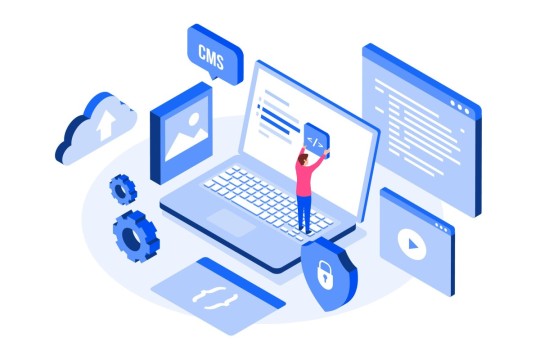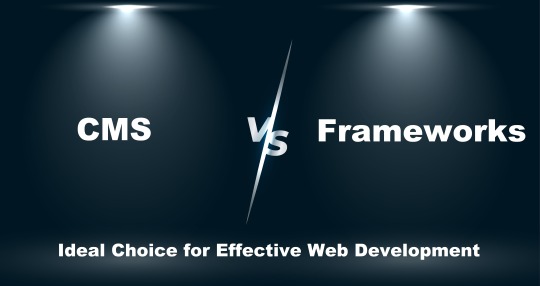#cms development frameworks
Text
Complete Guide on How to Select the CMS to Showcase Your Brand
Complete Guide on How to Select the CMS to Showcase Your Brand
A website is a great way to showcase your products and services to the world. But before building one, you must first select a CMS development framework for your website.
Think of CMS as a super-tool that seamlessly allows you to modify, add, or remove any text, image, audio, or video on your website. The right CMS framework can keep your online presence organized and looking great…

View On WordPress
#cms development frameworks#custom wordpress development company#custom wordpress development services#wordpress agency#WordPress development agency#WordPress development company#WordPress development company near me#WordPress development firm#wordpress website development services
0 notes
Text

Laravel Development Company
Elevate your digital presence with our premier Laravel development services. As a seasoned Laravel development company, we specialize in creating bespoke, cutting-edge solutions tailored to meet your unique business needs. With a meticulous focus on quality, efficiency, and innovation, we deliver robust web applications, scalable e-commerce platforms, and dynamic web portals powered by Laravel's unparalleled versatility.
Our team of Laravel experts boasts extensive experience in harnessing the full potential of this acclaimed PHP framework, ensuring seamless integration, exceptional performance, and unmatched reliability for your projects. From conceptualization to deployment, we adhere to industry best practices, leveraging Laravel's rich feature set to deliver solutions that exceed expectations.
Read more https://www.ibrinfotech.com/technologies/web-development/laravel-web-development-services-
#laravel development company#Laravel web development services#Laravel Development Companies#php framework#Laravel eCommerce Development#Laravel Website Development#Laravel Enterprise Services#Laravel CMS Development#website development process
0 notes
Text
20 Free Tailwind CSS Web Templates for Designers & Developers
New Post has been published on https://thedigitalinsider.com/20-free-tailwind-css-web-templates-for-designers-developers/
20 Free Tailwind CSS Web Templates for Designers & Developers
Tailwind CSS is a utility-first CSS framework for creating custom web pages quickly. Unlike traditional CSS frameworks that offer predefined components, Tailwind provides low-level utility classes that let you build unique designs directly in your HTML markup, giving you the flexibility to customize layouts without having to override any styles or navigate through complex CSS files.
Tailwind offers a practical, efficient, and customizable solution for modern web design challenges. These factors have contributed heavily to its growing popularity among developers and designers.
Speed & Efficiency: Tailwind speeds up the development process. You can style elements directly within HTML, reducing the back-and-forth between HTML and CSS files and making the process more intuitive.
Responsiveness & Flexibility: It includes a wide range of responsive, mobile-first utility classes that make it easy to build adaptable designs without custom CSS.
Customization: Tailwind is highly customizable. You can quickly adapt the default theme to match your project’s branding, creating a consistent look and feel across your website or app.
Community & Ecosystem: Tailwind CSS has a strong and growing community that contributes to a rich ecosystem of plugins, tools, and resources. This community support makes it easier for you to find solutions to problems and learn best practices.
Minimalistic Approach: By focusing on utility classes, Tailwind encourages a cleaner HTML structure with less code, leading to lighter websites and better performance.
Whether you’re looking for a simple portfolio or an eCommerce layout, these templates will lay the groundwork to help get your project up and running quickly. We selected each template based on its design quality, how easy it is to customize, and overall usefulness.
Tailwind CSS Blog Templates
These templates offer a range of styles for anyone who’s looking to create a simple blog. They all have a clean and basic design, making it easy to customize to match any brand or personal style.
Tailwind Dev Blog Template (Free)
Dev Blog is a simple Tailwind CSS template for web developers who want to launch a blog quickly. It features a two-page layout: a grid-styled homepage and a single-column blog page, ready for your personal customization.
Stablo Tailwind Blog Template (Free)
Stablo is a minimal and modern Tailwind CSS web template with a grid-layout homepage and single-column blog pages. It was built using Next.js and Sanity CMS and supports both light and dark modes.
Blogza Tailwind CSS Blog Template
Blogza is a premium Tailwind CSS template with seven homepage layouts, including a card-style grid layout and standard single-column options. Its simple, clean design is ideal for personalized styling.
Atlas Blog Template for Tailwind (Free)
Atlas is a clean, minimal Tailwind CSS template with a single-column layout. It offers light and dark modes, syntax highlighting for web developers, and includes pages for an introduction, blog, and contact.
Prima Persona Tailwind Blog Template (Free)
Prima Persona is a minimal, one-page Tailwind CSS template with a stunning bento grid layout. It features a clean, modern aesthetic with generous use of negative space and includes both light and dark modes.
Blogez Blog Tailwind CSS Template
Blogez is a Tailwind CSS template that offers six unique blog layout styles, all with a three-column card style. Its modern and clean design makes it an excellent choice for a broad range of content creators.
Tailwind Toolbox Minimal Blog Template (Free)
Minimal Blog is a starter template designed with a minimal aesthetic and a monochrome color scheme. It offers a single-column layout, features code blocks for technical content, and includes a newsletter subscription component.
Nextjs & Contentful Blog Template (Free)
This web template was built with Tailwind CSS, Next.js, and Contentful. Offering a clean design, it features a three-column grid layout for the homepage and a simple single-column layout for blog posts.
Tailwind Developer Blog Template (Free)
Developer Blog offers a Tailwind CSS template with a three-column card layout homepage, single-column blog post page, about me page, and contact page. Its simple design is ready for your personal customization.
Tokyo Blog & Portfolio Template (Free)
Featuring a minimal design, this web template has been built with Astro, Tina CMS, Netlify, and Tailwind CSS. It includes homepage, blog, projects, and about layouts, along with a functional rss.xml. It is ideal for web developers.
Tailwind CSS Startup & Agency Templates
Designed for startups and agencies, these templates will help you to quickly showcase services and projects with a polished look. All templates are flexible to suit various business needs.
Play Tailwind Startup Web Template (Free)
Play is an open-source Tailwind CSS template that includes all components and page layouts needed to launch a complete website. Ideal for design agencies, startups, SaaS, and various other businesses. It features a clean and modern design.
Base Tailwind Agency & Startup Template (Free)
Base is a Tailwind CSS template tailored for agencies and startups. With a modern and spacious design, its homepage comes with twelve different sections and components, catering to a variety of content needs. This is the lite version, the full version is also available.
WebAi Tailwind CSS Template
Webai is a complete website template that includes five homepage variations. It offers an extensive collection of pre-built Tailwind UI components and section blocks, making it ideal for startups and technology-related businesses.
TW Agency Tailwind Web Template (Free)
TW Agency is an open-source landing page starter template that’s ideal for various types of agencies. It includes basic components designed to help get your site up and running quickly.
Tailwind CSS eCommerce Templates
These templates have been built for quickly launching online shops. They all offer simple styling and user-friendly layouts, and are perfect for anyone looking to create a small eCommerce store.
Nordic Store Tailwind Template (Free)
The open-source Nordic Store is an eCommerce single-page web template with a clean grid layout for products and a simple featured product slider. Its minimal design is streamlined for showcasing items elegantly.
Shuuz Client Tailwind eCommerce Template (Free)
Shuuz is an eCommerce website template built using Tailwind CSS and Vue 3. It features a three-column homepage layout for showcasing products and a detailed product page. Its modern, minimal design is ideal for quickly creating an elegant online store.
Tailwind CSS Landing Page Templates
These simple Tailwind CSS landing page templates are ideal for promoting products, events, or services.
Nextly Tailwind Landing Page Template (Free)
Built with Next.js and Tailwind CSS, Nextly is an open-source landing and marketing page template. It offers both light and dark styles, features a modern design, and is suitable for a wide range of business projects.
Tailwind CSS Landing Page Template (Free)
This open-source Tailwind CSS landing page template includes a hero header, sticky navigation bar, hover effects, call-to-action buttons, pricing tables, and much more. It is perfect for anyone who needs to quickly create a marketing or business website.
Upwind Tailwind CSS Landing Page Template
Upwind is a multi-purpose Tailwind CSS template that comes with eight homepage variations and many beautifully designed components. Its modern and clean design makes it perfect for various marketing projects. Both dark and light modes are available.
Simple Light Landing Page Template (Free)
Simple Light is a landing page template that has been built with React, Next.js, and Tailwind CSS. It offers all the basic components a web developer needs to quickly create simple landing pages for many different types of marketing and business ventures.
Tailwind CSS Portfolio Templates
These portfolio templates offer a simple platform for designers and developers to quickly create a basic portfolio or online resume. They are highly customizable, allowing you to style your portfolio exactly how you want it.
Atom Tailwind Portfolio Template (Free)
Atom is a portfolio Tailwind template with a homepage layout and a single-post layout. The homepage features sections for your portfolio, services, clients, work, and blog, all designed for quick portfolio creation.
BoxModelDev Portfolio Template (Free)
Porto is a Tailwind CSS portfolio and resume web template. With its modular components, it has been designed to showcase your skills, projects, and experience through a clean and modern layout. It is ideal for web professionals looking to stand out.
Morex Tailwind CSS Personal Portfolio Template
Morex is a personal portfolio web template with a minimal layout and clean design. With light and dark options, three homepage templates, and numerous useful components, it is perfect for designers and developers looking to create a professional portfolio.
Getting Started with Tailwind CSS
Conclusion
Tailwind CSS templates simplify web design, offering quick customization and a path to unique, responsive sites. These templates can save you time and help you achieve a professional look with minimal effort.
Explore the wide range of available templates above to find the ideal fit for your next project. Start your search today and elevate your next web project effortlessly.
More Free Web Templates
Related Topics
Top
#amp#app#approach#atom#Blog#Branding#Business#buttons#classes#CMS#code#Color#Community#content#creators#CSS#CSS Layouts#Dark#Design#designers#Developer#developers#development#easy#effects#efficiency#Events#Featured#Features#framework
0 notes
Text
Django provides a signals framework that allows certain senders to notify a set of receivers when certain actions occur. This can be very useful for decoupling components of your application and keeping your code modular. Django's built-in signals can be used for model events by utilizing the django.db.models.signals module. Here's a step-by-step guide on how to use Django signals for model events
#django#django python#django developers#wagtail cms#django cms#django mongodb#django framework#django software#django framework python#celery with django#django use#django vscode#installing django#pandas django#stackoverflow#jsx#web design#web dev#web development#website#programming#backedn#backend eng#tech#technology#engineering
0 notes
Text
Django provides a signals framework that allows certain senders to notify a set of receivers when certain actions occur. This can be very useful for decoupling components of your application and keeping your code modular. Django's built-in signals can be used for model events by utilizing the django.db.models.signals module. Here's a step-by-step guide on how to use Django signals for model events
#django#django python#django developers#wagtail cms#django cms#django mongodb#django framework#django software#django framework python#celery with django#django use#django vscode#installing django#pandas django#stackoverflow#jsx#web design#web dev#web development#website#programming#backedn#backend eng#tech#technology#engineering
0 notes
Text
Django provides a signals framework that allows certain senders to notify a set of receivers when certain actions occur. This can be very useful for decoupling components of your application and keeping your code modular. Django's built-in signals can be used for model events by utilizing the django.db.models.signals module. Here's a step-by-step guide on how to use Django signals for model events
#django#django python#django developers#wagtail cms#django cms#django mongodb#django framework#django software#django framework python#celery with django#django use#django vscode#installing django#pandas django#stackoverflow#jsx#web design#web dev#web development#website#programming#backedn#backend eng#tech#technology#engineering
0 notes
Text
Django provides a signals framework that allows certain senders to notify a set of receivers when certain actions occur. This can be very useful for decoupling components of your application and keeping your code modular. Django's built-in signals can be used for model events by utilizing the django.db.models.signals module. Here's a step-by-step guide on how to use Django signals for model events
#django#django python#django developers#wagtail cms#django cms#django mongodb#django framework#django software#django framework python#celery with django#django use#django vscode#installing django#pandas django#stackoverflow#jsx#web design#web dev#web development#website#programming#backedn#backend eng#tech#technology#engineering
0 notes
Text
Laravel CMS Development: From Concept to Code
Introduction:
Welcome to the digital age, where content management is the heartbeat of every thriving website. In the realm of web development, Laravel CMS stands out as a powerhouse, offering an unparalleled combination of elegance and efficiency. Join us on a journey through the ins and outs of Laravel CMS development, as we explore the key concepts, best practices, and strategies for crafting dynamic and scalable websites.

Section 1: The Essence of Laravel CMS Development
In the fast-evolving landscape of web development, having a robust content management system is non-negotiable. Laravel, a PHP framework, has emerged as a preferred choice for developers seeking to create feature-rich, user-friendly, and maintainable CMS solutions. Let's dive into the core aspects that make Laravel CMS development a game-changer.
Section 2: Getting Started with Laravel CMS
Embarking on your Laravel CMS development journey requires a solid foundation. We'll guide you through the installation process, setting up your development environment, and creating your first Laravel CMS project. Harness the power of artisan commands and leverage Laravel's elegant syntax to kickstart your development process.
Section 3: Key Features and Benefits
Laravel CMS development comes loaded with a plethora of features that streamline the creation and management of digital content. Explore the benefits of eloquent ORM, blade templating engine, and artisan commands that enhance the efficiency of your development workflow. Discover how Laravel's modular structure facilitates easy customization and integration of third-party packages.
Section 4: Best Practices in Laravel CMS Development
To excel in Laravel CMS development, it's crucial to adopt industry best practices. Dive into the world of clean code, MVC architecture, and version control to ensure the maintainability and scalability of your CMS projects. Learn how to optimize database queries, implement caching mechanisms, and fine-tune performance for a seamless user experience.
Section 5: SEO Optimization in Laravel CMS Development
In the competitive digital landscape, search engine optimization (SEO) is paramount. Explore how Laravel CMS development can be optimized for search engines, ensuring that your websites rank high in search results. From URL structure to meta tags, we'll cover the essential SEO techniques that will elevate your Laravel CMS projects to new heights.
Section 6: Laravel CMS Development Case Studies
To truly grasp the potential of Laravel CMS development, let's delve into real-world examples. Explore case studies highlighting successful projects built on the Laravel framework. Gain insights into how leading organizations leverage Laravel CMS to achieve their digital goals and deliver exceptional user experiences.
Conclusion:
Laravel CMS development is a journey of innovation and empowerment. By embracing the elegance of Laravel's syntax, harnessing the power of its features, and adhering to best practices, developers can create dynamic and SEO-optimized websites that captivate audiences and stand the test of time. As you embark on your Laravel CMS development adventure, remember: the possibilities are limitless, and the future is yours to craft. Happy coding!
Frequently Asked Questions (FAQs)
Q1: What makes Laravel an ideal choice for CMS development?
A1: Laravel excels in providing an elegant and expressive syntax, making it easy for developers to create clean and maintainable code. Its modular structure, robust features, and active community support make it an ideal choice for building content management systems that are both efficient and scalable.
Q2: How do I optimize my Laravel CMS project for SEO?
A2: SEO optimization in Laravel CMS involves several key steps. Ensure your URLs are structured sensibly, use descriptive meta tags, and implement proper header tags within your Blade templates. Additionally, leverage Laravel's routing capabilities to create SEO-friendly URLs. It's also crucial to focus on high-quality content and mobile responsiveness.
Q3: Can I integrate third-party packages seamlessly into my Laravel CMS project?
A3: Yes, Laravel's modular architecture allows for easy integration of third-party packages. Utilize Composer, the PHP dependency manager, to install and manage packages effortlessly. Laravel's artisan commands simplify the process of integrating and configuring packages, enhancing the functionality of your CMS without compromising efficiency.
Q4: How does Laravel handle security in CMS development?
A4: Laravel prioritizes security through features like Eloquent ORM, which helps prevent SQL injection. The framework also provides built-in protection against cross-site scripting (XSS) and cross-site request forgery (CSRF) attacks. Laravel's comprehensive documentation includes guidelines on best security practices, ensuring developers can build secure CMS solutions.
Q5: Is Laravel suitable for large-scale CMS projects?
A5: Absolutely. Laravel's modular structure, eloquent ORM, and support for caching mechanisms make it well-suited for large-scale CMS development. By following best practices such as code optimization and efficient database queries, developers can create robust, scalable Laravel CMS solutions tailored to meet the demands of sizable projects.
Q6: Can I migrate an existing CMS to Laravel?
A6: Yes, Laravel provides tools for database migration and schema building, making it feasible to migrate an existing CMS to the Laravel framework. However, the complexity of the migration process depends on factors such as the current CMS platform and the extent of customization. It's advisable to conduct a thorough analysis and plan the migration carefully.
Q7: How can I contribute to the Laravel CMS development community?
A7: Joining the Laravel CMS development community is encouraged! Contribute to open-source projects, participate in forums, and share your knowledge. Laravel's GitHub repository is a great place to start. Engaging with the community not only enhances your skills but also fosters collaboration and innovation within the Laravel ecosystem.
0 notes
Text
How to choose between CMS and Frameworks for Enhanced Web Solutions?

Developers possess keen expertise in both CMS as well as Frameworks with their regular practices and hands-on trails as well as implementations. But they have to choose the ideal one depending on the budget, functionalities required and other related factors that drives the decision towards either of the CMS & Frameworks. Drive through the article below to understand about the the key factors that will help you make your decision in no time and accordingly leverage their best features & functionalities - https://www.vegamoontech.com/the-digital-strategy-blog/emerging-technologies/cms-vs-frameworks-ideal-choice-for-robust-web-development/
#web development#cms vs frameworks#best web development approach#why choose frameworks#why choose cms
0 notes
Video
youtube
Yii Framework Development Company India
World Web Technology is the best Yii Framework Development Company in India. we deliver top-of-the-class Yii Framework development services to all our clients. Are you looking Yii PHP framework development company? Contact Us Now.
#yii development company india#yii framework development#yii framework development company#yii framework development india#yii php framework development#yii cms application development#yii framework development services#yii development services#yii application development company#hire yii developers
0 notes
Text
Product owners must juggle many considerations, such as data interoperability and security. To meet all these requirements, most decision makers choose Laravel framework development. There are several advantages of Laravel as a well-known open-source PHP framework, especially for healthcare applications. Entrepreneurs should use Laravel to build healthcare apps because it is quick and efficient. Let's look at why this is the case in detail.
#laravel cms development#laravel development#laravel framework development#laravel development company#laravel web development company
1 note
·
View note
Text
Best landing page CMS| Make creating landing pages easier than ever!
A CMS, or Content Management System, is a tool that helps you create and manage your website's content. A landing page CMS is a specific type of CMS that is designed to help you create and manage landing pages on your website. Landing pages are important because they are the first thing that people see when they visit your website, so it's important to make sure that they are well-designed and informative.
Best CMS Landing Page Builder
OXO is a powerful, yet easy-to-use landing page CMS. With OXO, you can create beautiful, responsive landing pages in minutes - without having to code! Plus, OXO comes with all the features you need to create a successful landing page, including A/B testing, email capture forms, and more.
#landing page#landing page builder#landing page design#landing page optimization#landing page templates#uidesign#website builder#cmssoftware#cmswebsitedevelopment#cms development company#php script#laravel#javascript#java web frameworks#lead generation#technology
1 note
·
View note
Link
To speed up the web development process, PHP frameworks are required. Today, there are a variety of PHP frameworks available on the web, but the two most well-known PHP frameworks are Laravel and CodeIgniter. We are a well-known bespoke web app development firm that provides a wide range of web development services and cheapest website development to meet your organization's needs.
#laravel#codeigniter#cms web development company#cmsdevelopment#web design#web development#php framework
0 notes
Text










Collective memories
You may have come across Semioticapocalypse, a blog I started—frightening to consider how long ago it was, — that became essentially the origin of the «Collective Memories» (CM). Both Semioticapocalypse and the CM project emerged primarily from my longstanding love for black-and-white photography, which later evolved into an interest in its history and theory. Secondly, thу new enterprise owes much to the staggering and mesmerizing impact that the Cambrian explosion in the world of generative models has had (and continues to have) on me, particularly when it comes to diffusion models, generating images visual or textual inputs as well as from various combinations of thereof.
The term "collective memory" denotes the aggregate of memories, knowledge, and data that a social group holds, which is intrinsically linked to the group's identity. The term "collective memory" in English and its French counterpart "la mémoire collective" emerged in the latter half of the 19th century. Maurice Halbwachs, a philosopher and sociologist, further developed this concept in his 1925 work, «Les cadres sociaux de la mémoire» (eng. text). Both expansive and intimate social collectives can create, disseminate, and inherit collective memory.
Contrary to the term "collective memory," which is somewhat ambiguously defined yet generally accepted, the notion of "collective memories" is inherently problematic. Memories are the results of the individual acts of recollection, making the idea of "collective memories" paradoxical. Сontemporary diffusion models utilize vast amounts of often unidentified data, including historical and personal old photographs, vintage postcards, and other kinds of publicly circulating images. These models may be seen as involved in the prompts-driven singular acts of remembrance, producing images that paradoxically represent "collective memories," something otherwise unfeasible and ultimately, non-existent.
The visual works published here and elsewhere on this blog were created using Midjourney. Each of them comes as the result of finding optimal (for lack of a better world) combined text/image prompt through exhaustive search a. k. a. generate-and-test method; the process is apparently as labor-intensive as it is time-consuming. The major part of the works belongs within the "Collective Memories" framework. In addition to visuals there will be eventually / hopefully a p2p publication or two.
Past works that align with the CM project in terms of both concept and style, even if not published as such, can be found on Behance. Then there's Instagram (crowв there is kind of thin but I'm set on daily updates). Last but not least, there are sporadic posts on Facebook, in designated groups only, — primarily 'MJ Official' (weekly or so) and another nice one here (occasionally). In case you would like (for whatever reason) to buy NFT or two, it can be arranged via Makers Place: drop me a line.
#midjourney#ai#ai art#ai generated#generative#generative art#retro style#neurophotography#promptography#disturbing#weird#hybrids#collective memories#memory studies#surreal#public history#vintage style
115 notes
·
View notes
Text
Adding authentication to Django REST Framework (DRF) views involves configuring authentication classes in your DRF settings. DRF provides a variety of authentication classes that you can choose from based on your project's requirements. Here's a general guide on how to add authentication to DRF views
#django#django python#django developers#wagtail cms#django cms#django mongodb#django framework#django software#django framework python#celery with django#django use#django vscode#installing django#pandas django#stackoverflow#jsx#web design#web dev#web development#website#programming#backedn#backend eng#tech#technology#engineering
0 notes
Text
Adding authentication to Django REST Framework (DRF) views involves configuring authentication classes in your DRF settings. DRF provides a variety of authentication classes that you can choose from based on your project's requirements. Here's a general guide on how to add authentication to DRF views
#django#django python#django developers#wagtail cms#django cms#django mongodb#django framework#django software#django framework python#celery with django#django use#django vscode#installing django#pandas django#stackoverflow#jsx#web design#web dev#web development#website#programming#backedn#backend eng#tech#technology#engineering
0 notes